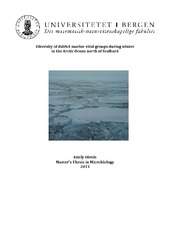Diversity of dsDNA marine viral groups during winter in the Arctic Ocean north of Svalbard
Master thesis
Permanent lenke
http://hdl.handle.net/1956/10976Utgivelsesdato
2015-10-22Metadata
Vis full innførselSamlinger
Sammendrag
Extreme changes in light and cold water temperatures throughout the annual cycle in the Arctic Ocean create a unique habitat that selects for particular microorganisms - including marine viruses. This study investigated diversity of ecologically significant viral groups at two marine sampling stations during the dark period in the Arctic Ocean north of the Svalbard archipelago through pyrosequencing of signature genes. Sequence data for three viral signature genes (g23, phoH, and MCP) were examined within the context of physical and biological environmental parameters to characterize the viral communities within several Arctic Ocean water masses of differing origin. Genotypic fingerprinting information from previous T4- like virus diversity investigations was used to explore phylogenetic relationships between Arctic Ocean g23 genotypes examined in this thesis to a global diversity of T4-like viruses isolated from various environments. Our findings show that marine viral communities exhibit dominant and rare types that vary proportionally in abundance between water masses, and that the available prokaryotic host communities vary similarly. The biogeographic examination showed that many of the dominant Arctic Ocean T4-like genotypes from this study are possibly endemic to the arctic, while others show similarity to globally distributed types, supporting the paradigm that local viral diversity may be high while also being low globally. Additionally, this study compared sequenced datasets of g23 amplicons from the same water samples generated using three widely- implemented sequencing platforms (Roche/454, Illumina, and Ion Torrent) in order to assess comparability of data from newer platforms for viral diversity investigations to pyrosequencing data. The platform comparison revealed that clustering of signature gene sequences into OTUs based on 90% similarity resulted in preservation of broad patterns in between-sample diversity, and also that sequence read data generated using Illumina appear most similar to Roche/454. The author therefore recommends the Illumina platform for continued use of primers for amplification of viral signature genes developed for pyrosequencing.
